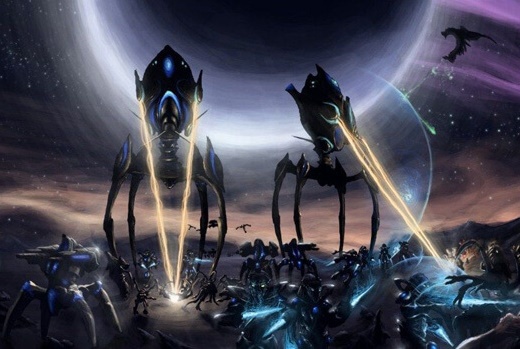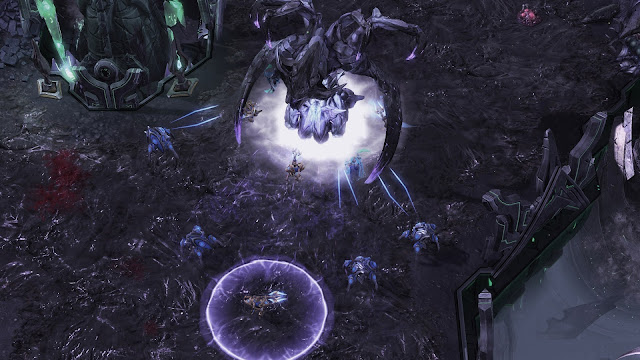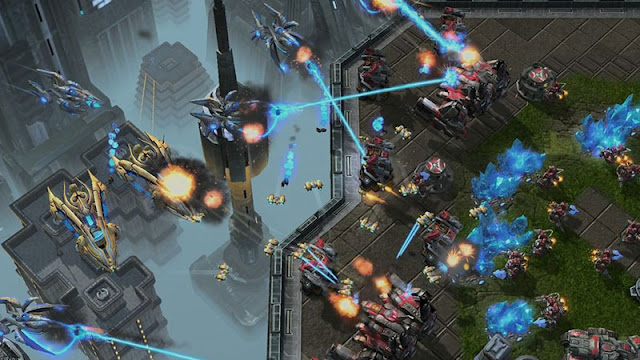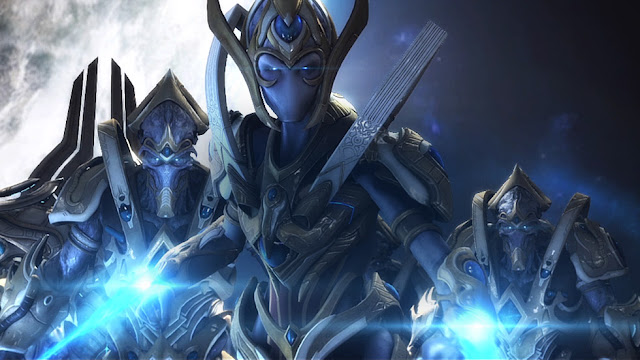Starcraft has always been a titan in the RTS genre. It’s been a series spanning nearly two decades now which perfected PvP RTS gameplay, asymmetrical balance and was responsible for the formation of the e-sports scene, all while boasting some of the best narratives, characters and expanded lore in gaming. The interplanetary struggle of the humans, or Terrans, the opulent and wise Protoss and the aggressive, insectoid Zerg have penetrated both gaming and mainstream culture, from “you must construct additional pylons” to the ever frustrating “Zerg rush”. It’s so big that Starcraft 2 is actually released as three separate games: Wings of Liberty in 2010, Heart of the Swarm in 2013 and now finally Legacy of the Void in 2015. This standalone game, focusing on the Protoss race, will serve as a conclusion to the grand Starcraft narrative started way back in 1998 and will be the capstone for the series.
Legacy of the Void actually feels a lot like three games in one. You have the campaign, casual multiplayer and competitive multiplayer. I’ll spend a good amount of time on each of these since the expansion works wonders for every facet, but I’ll split them up because each one is catered to a very different audience.
Starting with the campaign, Legacy of the Void follows the actions of Artanis, the leader of the remnants of the Protoss, struggling to keep his civilisation alive and fight back against an ancient evil after the once proud warrior race had been beset by attacks and factioning. Chronologically the story follows on from Wings of Liberty and Heart of the Swarm, but because the focus is on the story of a single character,Artanis, it’s actually quite enjoyable even if you aren’t familiar with the rest of Starcraft 2. While Wings was a western and Heart was a revenge story, Legacy of the Void is well and truly a space opera, and it feels even more epic than the two games which preceded it. We’re not just dealing with rebel uprisings anymore, we’re talking about the fate of the entire universe. There are some amazing setpiece moments in the narrative which will have you cheering in your seat. With Legacy, the team at Blizzard understood they were designing the end of a trilogy and the end of a grand story arc, so they really pulled out all the stops to give the player a sense of closure and triumph.
As for the gameplay, Legacy of the Void follows the same design philosophy as Heart of the Swarm, in that players are given a variety of campaign specific abilities which massively break the power curve of the game and make the player feel empowered. While Heart of the Swarm had you controlling Sarah Kerrigan as a unit and developing her powers, Legacy of the Void gives the player external support from a massive orbiting spaceship known as the Spear of Adun, opening up options such as dropping pylons anywhere on the map to warp in units immediately, all the way to global shields, teleports and damage. Your ground units will also have access to a variety of upgrades to make them much more powerful, which you unlock as the campaign runs its course. These leave the player feeling very dominant indeed and it’s possible to steamroll through the casual and normal difficulty modes without your enemies ever breaking your shields, and yet the hard and brutal modes still managed to give me a run for my money. It’s a testament to Blizzard’s good design that even though each unit feels overpowered, they are still all situational and each scenario is perfectly choreographed to challenge players to make meaningful choices and efficient decisions. Missions are short and sweet with the longest hitting around an hour.
The Campaign mode still stands as the perfect mixture of narrative and gameplay. In universe, the Protoss were a powerful civilisation which was technologically advanced, knowledgeable and lavish, akin to an alien Babylonian Empire. Despite this, their homeworld of Aiur had been besieged and the remaining Protoss are factioned across planets and belief systems. This is perfectly reflected in the units you have access to: throughout the campaign Artanis gains more and more allies as he unites the Protoss and you will be fighting with a mixture of hastily assembled troops and refurbished ancient tools of war. The Protoss always had a micromanagement heavy playstyle where players needed to manage a large variety of units and use each one to its fullest potential, and the campaign is designed to reflect that in every way. For all of these reasons, the Legacy of the Void campaign is one of the most enjoyable single player RTS experiences I’ve had in a long time and it’s worth a look even if you’re mostly in it for the multiplayer.
Speaking of multiplayer, Legacy of the Void certainly has big shoes to fill. Since the big upsurge of MOBA games such as League of Legends and Blizzard’s own Heroes of the Storm have drawn players away from Starcraft, this expansion needed to be deep and strategic enough to satisfy the existing pro scene while also being accessible enough to draw in new players. In an attempt to remedy this, Blizzard has incorporated various casual multiplayer options to ready players for competitive multiplayer, since the skills required in the campaign are not really transferrable to PvP. Legacy of the Void sees the introduction of Archon mode, co-op mode and the return of the Arcade for when you want to play multiplayer without the stress of head-on competition.
Archon mode, named after the Protoss unit which is two Templars fused together, allows two players to have simultaneous control of the same army. Archon mode has the benefit of making lower level games much more fun to watch, since two players will be able to pull off the complex tactics a pro level player would normally do solo. It’s also a great way to learn the mechanics of the game since one player can focus either purely on base management or on attacking, or on managing a smaller squad of micro intensive units rather than the entire army. It definitely takes some coordination and communication to pull off, but with some easy ground rules it’s a fantastic addition to the multiplayer experience.
My favourite addition however has got to be the co-op mode. In this mode, each player is assigned a pool of units and abilities based on one of the characters from the campaign, and must team up with another human player to complete a pre-determined scenario. The design of this mode necessitates teamwork: objectives are split up across the map and on the harder difficulties it’s impossible to do alone. Furthermore, each player is only given a limited spectrum of their race’s units so players will need to work together to fill in the strengths and weaknesses of their army composition. Because it is PvE, co-op mode is never as stressful or high stakes as PvP, so it’s a great way to make friends and expand the Starcraft community beyond intense 1v1 games. Currently there are six possible characters to play as and six scenarios, but hopefully more will be added as the game goes on.
When the base game becomes tiresome however, Legacy of the Void sees the return of the Arcade mode where the community is able to make mods and extra games using the robust Starcraft II engine. The creativity of the players is astounding and it’s a fantastic way to unwind after being stressed out by the game proper. There are also a variety of skill trainers which newer players would be wise to check out. Now to talk about competitive multiplayer, Blizzard has made a few changes to the way PvP works in order to shake up the stagnant meta of Heart of the Swarm. A lot of these might seem like small changes, but once you’ve played a game the difference is immense, so much so that you’ll need a few games against bots just to regain your bearings. The overall philosophy of Legacy of the Void is to make faster games with a greater focus on micromanagement so that players who show up to fights with a smaller army still have a chance of winning the engagement. It’s a determined decision to reduce “down time” when both players are passively massing resources and the outcome of the match is fairly predictable. In Legacy of the Void, there’s always going to be something happening and always something to worry about.
The biggest change for all players is the reworking of the economy. Now instead of six starting workers, everyone gets 12. Resources also don’t last as long as they used to, and minerals are saturated at around 18 workers instead of the original 24. This means you’ll need to expand much earlier and much more often, and doing that means you’ll be inching towards your opponent, and making yourself vulnerable, much more often than before. Turtling on two or three bases is now pretty much a non-option, and instead things like expansions before 1 minute are commonplace. Game length is also much shorter, with even the tutorial suggesting that you should aim to make your game winning push at around the 14 minute mark.
As for new units, Terran gets a new flyer called the Liberator which deals AoE damage to air targets, which can also enter siege mode to deal heavy damage to ground targets. There’s also a new mech, the Cyclone, which can move while attacking and can lock on to big targets for massive damage. Reapers also get their grenades from Wings of Liberty back, and there are a few upgrades that have been moved to the Fusion Core so that building is no longer a distant, expensive dream. Protoss get a new ranged gateway unit called the Adept which is a great augmentation to the Zealot-Stalker lineup, and also a mech called the Disruptor which can manually fire a ball of energy, dealing damage to an area. The Protoss lategame airforce have also been buffed significantly, and Carriers now create a field of instant win just like the SC1 days. Zerg get upgrades to their Roaches and Hydralisks; the Ravagers and Lurkers respectively, which both gain manually activated area of effect attacks. Nydus Worms have also been buffed significantly to allow greater global movement, and the Swarm Host has been reworked to be more aggressive, rather than a unit mostly used in turtling strategies.
The common theme in a lot of these reworks is that there are a lot of units with activated and manually targeted abilities, so there is a much higher skill ceiling involved with army-to-army battles. I feel that this also results in a higher skill floor, since there’s a lot more to worry about while fighting and army compositions are a lot more complex than they used to be. It’s definitely tough to grasp if you are new to the game, so I certainly don’t recommend jumping straight into ranked matchmaking. I did, feeling confident after my hours sunk in Heart of the Swarm, and lost my first five games all before the 10 minute mark to opponents who destroyed my mineral line in seconds and rocked up to fights with twice as many units as I did. Legacy of the Void is fast, frenetic and stressful, but definitely much more exciting to watch and play (if you’re good, of course).
Legacy of the Void is a triumphant swan song for the Starcraft 2 trilogy, boasting a fantastic Campaign mode, fun casual multiplayer and a robust competitive multiplayer scene. Starcraft is a game about planning and forethought, and that’s definitely something that Blizzard had in mind when making Legacy of the Void: in its aims to finish the Starcraft narrative, accommodate for new players and reinvigorate the competitive scene, this game is everything that it needs to be. There’s really something for everyone in this title regardless of your experience in RTS games, with a great story, heaps of different ways to experience the game’s content for all skill levels and for those who want to be the very best, there’s a gauntlet of tough opponents just waiting for you.
– Harvard L.
Contributor











